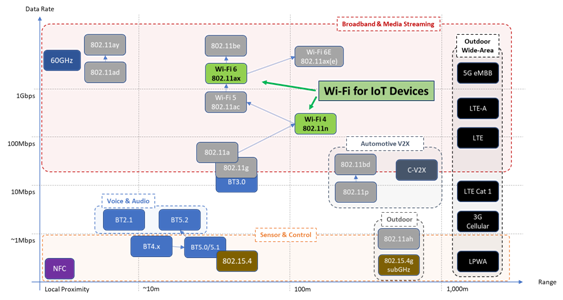
Silicon Labs products deliver the performance, energy savings, and simplicity needed to build a smarter, more connected world. With innovative technologies, Silicon Labs is shaping the future of IoT, industrial automation, smart home etc. In this exclusive interview Dr. Manish Kothari, Sr. Vice President of Software Development, Silicon Labs speaks about wireless IoT, innovation, challenges and applications.
1. What are the main challenges today for IoT design?
The challenges associated with IoT devices are completely different from the traditional designs which were typically wall-powered and had significant compute resources.
Most of the IoT designs have limited compute and memory resources which need to take care of the connectivity and the application. Battery life is extremely important as the user should not have to change the battery very often. IoT devices are often space constrained and cost sensitive devices (e.g., wireless sensors).Since the number of IoT devices is increasing every day, there is a significant crowding in the RF spectrum. The IoT devices are expected to continue to provide robust connectivity in the crowded environment with limited power and compute resources!
To simplify the IoT device development process, the wireless and networking stacks are expected to be integrated with the wireless solution. Not just that, complete cloud connectivity to major cloud providers is a must-have as well. Security is becoming more and more important as hackers are trying to hack into these IoT devices.
As more and more IoT devices are getting deployed, it is becoming critical for them to operate with each other. For example, Smart lock should be able to connect to the Wi-Fi router and smart phone. Some other devices like smart watches need connectivity to audio headset and sensors as well.
So, overall IoT devices need different hardware and software solutions than the traditional devices like laptops and mobile phone. One-size-fits-all approach dos not really work.
2. Which are the wireless technologies suitable for IoT?
There are many wireless protocols being used in IoT devices including Wi-Fi, BT, BLE, Zigbee, Thread and cellular. The choice of wireless communication protocols for a particular device depends upon the application, size, cost, power, and several other factors. For example, BLE is a good protocol to use for home temperature sensor as it consumes low power, it is lower in cost than some other protocols and provides the necessary range in a typical home environment.

The above chart is a simplified view of various wireless protocols and their applications. On the x-axis is the effective range of a protocol and on the y-axis is the application throughput provided by a protocol. Both are in logarithmic scale – range on x-axis is going to over 1000m and throughput on y-axis is going to over 1 Giga bits per second.
NFC is at the left bottom of the matrix as it provides the lowest throughout and the shortest range making it ideal for contactless payment like applications. On the right top with longest range and highest throughput is 5G. There are many protocols in the middle.
For example – Bluetooth Classic is used for primarily used for short range audio applications. BLE and ZigBee are primarily used for sensor and control applications due to their low data throughput and low/medium range. On the right side of the chart is the cellular network which provides wide area connectivity. It has a range of technologies including LPWA which provides low throughput to 5G which provides very high throughputs. It is typically used as an internet connectivity backbone for several mobile IoT devices.
Wi-Fi falls in the middle of the spectrum on the range and provides medium to high throughput based on the application requirements. There is single stream 802.11bgn which is at the lower end of the throughput spectrum and 802.11ax MIMO on the higher end of the spectrum.
As you can see, there are many protocols in the IoT space and each one of them is playing a specific role. Over time, there will certainly be some consolidation in these technologies.
3. What are the technology advantages of Wi-Fi as compared to other wireless technologies?
Wi-Fi is the most widely used and understood wireless standard in the world which is making it the de-facto standard for IoT devices. It has the necessary security and IP layer integration which simplifies the creation and deployment of IoT devices. It also provides much higher application throughput as compared to most of the other wireless technologies. However, it was not the primary protocol for IoT devices a few years back due to higher cost and power. With the reduction in these, 802.11n, also called as Wi-Fi 4, has become the dominant protocol in IoT devices. Out of the total 3-4 Billion Wi-Fi deployments annually, 800M are IoT devices and 200M out of these are battery powered devices. Wi-Fi 6 is expected to further increase the deployment!
4. How is Wi-fi 6 evolving for IoT applications?
Most of the IoT devices use Wi-Fi 4 today. Wi-Fi 6 was introduced in 2019 and infrastructure deployments are going on – most of the new routers have Wi-Fi 6 capability. We expect deployments of IoT end-devices with Wi-Fi 6 to start picking up in 2023 timeframe as it has significant benefits.
Wi-Fi 6 provides significantly higher throughput as compared to the previous Wi-Fi generations. However, most of the IoT devices do not need the higher throughputs offered by Wi-Fi 6. There are large number of other benefits of Wi-Fi 6 which will drive the growth in the IoT devices.
The biggest benefit of Wi-Fi 6 for IoT devices is that it can support many coexisting devices in a dense environment even in 2.4 GHz spectrum due to OFDMA and MU-MIMO technologies. Since the number of IoT devices is multiplying every year, Wi-Fi 6 will enable them to perform well and co-exist without the need to move to 5 GHz or 6GHz spectrum which adds to the cost and power.
Wi-Fi 6 has a new feature call Target Wake Time or TWT which enables the end device to wake at target times and look for data instead of a periodic wake up. This reduces the power consumption significantly which is critical for IoT devices.
In indoor deployments, range is extremely critical which will improve in Wi-Fi 6 due to beam forming and MU-MIMO. In addition, Wi-Fi 6 also provides a more reliable connectivity as compared to the previous generations.
Overall, Wi-Fi 6 is an important step for IoT devices. Wi-Fi 4 is already getting deployed widely in IoT devices and we expect the growth to continue further with Wi-Fi 6.
Silicon Labs has Wi-Fi 4 devices in production today and Wi-Fi 6 are in the roadmap to be released soon. Stay tuned!
5. Please tell us about your wireless IoT products and solutions?
IoT devices today are pushing the envelope on cost, performance, power, security, and integration. There are multiple wireless protocols being used in various IoT devices (as indicated above) which need to co-exist and inter-operate with each other increasing the complexity manifold. Silicon Labs’ mission is to create wireless solutions for the IoT market for building a more connected world. We have products in all leading wireless technologies needed by the IoT devices including Bluetooth, Wi-Fi, Zigbee, Thread, Z-wave, proprietary wireless, Wi-Sun, Sidewalk and Matter. We also have products which enable simultaneous operations of multiple protocols which is a critical requirement for the IoT devices. High security and low power are two important pillars of all our products, and we continue to innovate on these with every new generation. We are active in all the wireless alliances and stay on the leading edge of wireless technologies. One of the recent additions to our portfolio is Matter where we are actively involved with the CSA and driving the development. Silicon Labs is one of the largest code contributors on Matter alongside some of the major ecosystem provides. Silicon Labs is the only company with such a wide array of wireless products tied together by a unified development environment providing an easy to integrate solution for the IoT system developers. We are also the only company that provides the cost, performance, power, security, integration, wireless co-existence, and interoperability needed for IoT devices!
6. Which are the major applications targeted for these products?
Our products are deployed in a large range of applications. At a high level, we are focused on IoT end devices for smart home, life, industrial, medical, and commercial applications.
7. Please tell us about your BLE modules and its applications.
Silicon Labs has a broad portfolio of BLE SoCs and modules which provide an optimal solution for almost every IoT application including smart home, smart lighting, wearables, building automation, industrial systems, portable medical appliances, and a lot more. Our Bluetooth products have so far powered over 1+ billion IoT devices globally. We also have multi-protocol solutions which support a combination of Wi-Fi, BT Classic, Bluetooth Low Energy, 802.15.4/ZigBee/Thread, Matter, and proprietary wireless solutions. We just launched our BG24 and MG24 family of products which have integrated BLE and an AI/ML hardware accelerator for bringing ML processing to the edge. BLE is important technology for IoT devices and Silicon Labs is a leader in solutions with BLE. We will continue to innovate and bring the latest hardware and solutions with integrated BLE.
8. How will you describe your leadership in wireless SoC?
Silicon Labs is focusing on “intelligent wireless connectivity for IoT devices”. We have the widest portfolio of wireless solutions in the industry including Wi-Fi, Bluetooth, 802.15.4/ZigBee/Thread, Z-Wave, and proprietary wireless. We also have support for the new leading protocols such as Matter, Wi-Sun, and Sidewalk. We have the lowest-power and highest security devices in the market needed for battery operated devices. We have recently announced industry’s first wireless SoCs with built-in AI/ML hardware accelerator for faster processing and lower power for ML processing. In a nutshell, we have all the components needed for developing leading edge IoT devices and we will continue to innovate further!
9. What is your focus for 2022? Any new launch expected soon?
We just announced two new product families, BG24 and MG24, which support multiple wireless protocols including Matter and have an integrated AI/ML accelerator for processing at the Edge. We will continue to innovate on the wireless SoCs to bring leading edge solutions including the latest wireless protocols such as Wi-Fi 6, Matter, Sidewalk and Wi-Sun. We will also continue to strengthen our position in security and low-power. We do have several exciting announcements planned for the rest of the year!
10. Please tell us about your India developments in hardware and software design.
Silicon Labs India came as part of the Redpine Signals acquisition in April 2020. This center was the main hardware and software development center for Redpine Wi-Fi products, but we have expanded significantly since the acquisition and are developing several other products in the India center. The goal is to become the leading wireless IoT development center in the region. Silicon Labs, a leader in secure, intelligent wireless technology for a more connected world, is aimed to build up this center as one of the main hardware and software development center for wireless technology globally.






